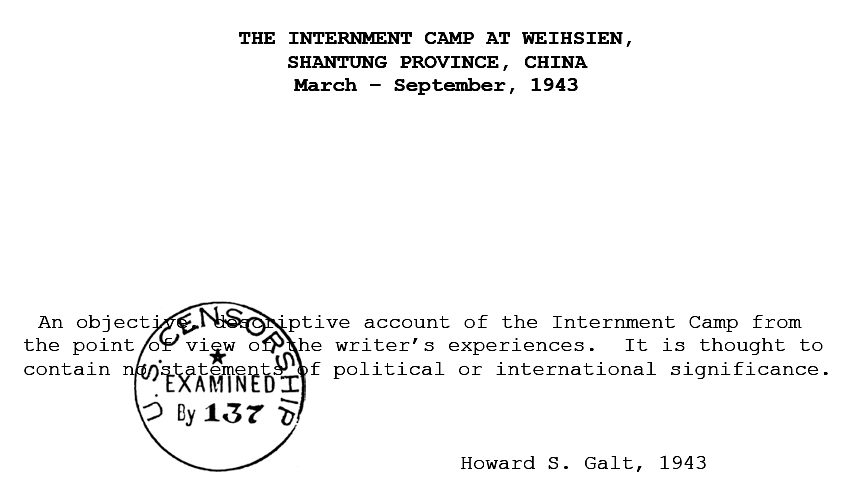
by Howard S. Galt
[excerpts] ...
[...]

Communications
The communications facilities of the camp with the outside world were strictly controlled and very limited.
Newspapers, especially the Peking Chronicle, were admitted, though quite irregularly and not in continuous series. There was a camp post office, which censored and much delayed incoming letters.
Packages from outside friends in Peking, Tientsin, and Tsingtao mostly containing food (after reports of the limited camp fare had gone out) began to arrive in large quantities and after some delay was delivered upon the payment of small fees.
Outgoing letters or postcards were limited as to frequency of posting, content, and form of hand-writing.
Post cards were usually limited to 50 words, and letters to 150 words. In both cases, block letters or type writing were required.
In such circumstances there were some arrangements for secret communications “over the wall,” but these were very limited. In a community thus circumstanced rumours were rife, much discussed and quickly disseminated.
They were concerned with all topics of interest, both serious and comic. Rumours in serious subjects were usually not taken seriously, but they offered interesting topics of conversation while we were so isolated from happenings in the outside world.
[further reading] ... http://www.weihsien-paintings.org/DonMenzi/ScrapBook/1943-03to09-TheInternementCampAtWeiHsien.pdf
N.D.L.R.
Léopold Pander:
The majority of the books about Weihsien, written after our imprisonment (a few years after WWII), hardly mention the communication techniques used by the camp “Committee” — especially after Tipton & Hummel’s escape.
Even Langdon Gilkey doesn’t mention the cess pool mailbox in his book considered to be a very complete description of our life in Weihsien.
He describes himself as very connected to the important individuals of the “Committee” but misinformed as to the numerous letters flowing in and out of the camp — all, unnoticed by the Japanese and apparently, the other prisoners too. Not once — in his book — does he mention an alias for Father Raymond deJaegher as he did for many other individuals. The best I could find as to a possible description of Raymond deJaegher was — on page 204: “... a discreet Missionary” and on page 175: “the Jesuit”.
#
Léopold Pander:
The majority of the books about Weihsien, written after our imprisonment (a few years after WWII), hardly mention the communication techniques used by the camp “Committee” — especially after Tipton & Hummel’s escape.
Even Langdon Gilkey doesn’t mention the cess pool mailbox in his book considered to be a very complete description of our life in Weihsien.
He describes himself as very connected to the important individuals of the “Committee” but misinformed as to the numerous letters flowing in and out of the camp — all, unnoticed by the Japanese and apparently, the other prisoners too. Not once — in his book — does he mention an alias for Father Raymond deJaegher as he did for many other individuals. The best I could find as to a possible description of Raymond deJaegher was — on page 204: “... a discreet Missionary” and on page 175: “the Jesuit”.
#
#








